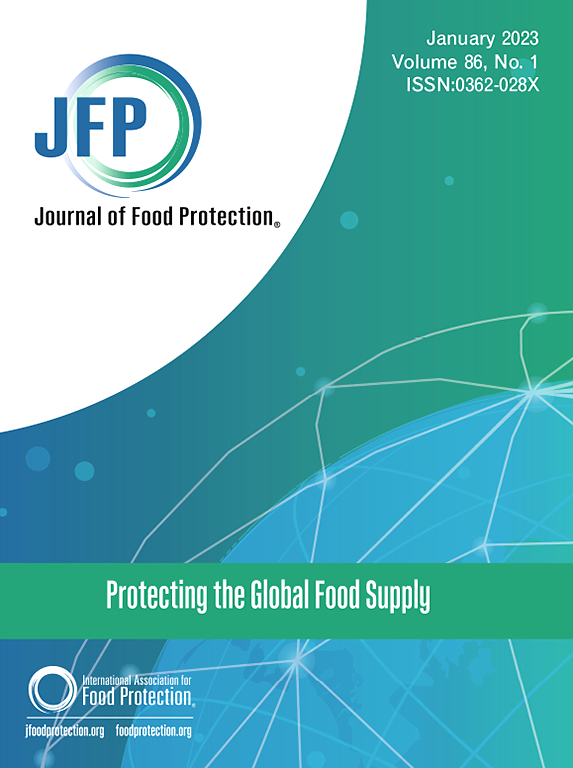Aggregative Sampling Performs Similar to Composite Produce Samples to Recover Quality and Safety Indicators Throughout Romaine Lettuce Production
IF 2.1
4区 农林科学
Q3 BIOTECHNOLOGY & APPLIED MICROBIOLOGY
引用次数: 0
Abstract
Aggregative sampling using polymer cloth swabs is a nondestructive, potentially more representative food safety sampling alternative for leafy greens. This study compared aggregative and produce tissue grab sampling to recover aerobic bacteria, total coliforms, and generic Escherichia coli, from commercial romaine grown in 120 m fields, with 5–36 samples at various stages. Aggregative swabs and grab samples were collected preharvest. During harvest, aggregative swabs were collected from romaine exiting the harvester chute, transport bin tops, and as gloves worn by harvesters. Romaine grabs were collected from transport bin tops and trim leftover on the ground. During postharvest, gloves, swabs, and grabs were collected from romaine exteriors, and swabs and grabs from head interiors. In preharvest, swabs had 1.2 log(CFU/g) higher means of aerobic bacteria than romaine tissue grab samples (p < 0.001), but 1.7 log(CFU/g) lower coliforms (p < 0.001). In-harvest, aerobic bacteria means from gloves worn by harvesters and swabs from harvester chute were 0.5 log(CFU/g) higher than romaine samples from leftover trims (p < 0.001) and bin tops (p = 0.01), respectively. Coliform recovery means from gloves was not significantly different from romaine leftover trims (p = 0.99). Swabs from harvester chute and bin tops recovered 1.6 and 1.4 log(CFU/g) lower coliforms means (p < 0.001) than romaine from bin tops, respectively. Generic E. coli was only recovered from one romaine leftover trim grab sample. During postharvest processing, aerobic bacteria (p = 0.25) and total coliforms (p = 0.16) recovery from the exterior of heads was not significantly different between gloves and romaine samples, nor was aerobic bacteria (p = 0.17) and total coliform (p = 0.86) recovery from head interiors. These results suggest that aggregative sampling performs similar to produce grab sampling to recover quality and safety indicators and justifies testing these methods for pathogen sampling in leafy greens.
在整个长叶莴苣生产过程中,综合抽样执行类似于复合产品样品的质量和安全指标。
使用聚合物布拭子的集合抽样是一种非破坏性的,可能更具代表性的绿叶蔬菜食品安全抽样选择。本研究采用5-36个不同阶段的样品,比较了120米田地中种植的商品生菜的聚集和生产组织抓取取样,以恢复需氧细菌、总大肠菌群和通用大肠杆菌。采集前采集集合拭子和抓手标本。在收获期间,从离开收获槽的长叶莴苣、运输箱顶部和收获人员戴的手套中收集聚集性棉签。从运输箱顶部和地面上的修剪剩余物中收集生菜。在收获后,从生菜外部收集手套、棉签和抓抓物,从头部内部收集棉签和抓抓物。在收获前,棉签的好氧细菌平均值比生菜组织样品高1.2 log(CFU/g)
本文章由计算机程序翻译,如有差异,请以英文原文为准。
求助全文
约1分钟内获得全文
求助全文
来源期刊

Journal of food protection
工程技术-生物工程与应用微生物
CiteScore
4.20
自引率
5.00%
发文量
296
审稿时长
2.5 months
期刊介绍:
The Journal of Food Protection® (JFP) is an international, monthly scientific journal in the English language published by the International Association for Food Protection (IAFP). JFP publishes research and review articles on all aspects of food protection and safety. Major emphases of JFP are placed on studies dealing with:
Tracking, detecting (including traditional, molecular, and real-time), inactivating, and controlling food-related hazards, including microorganisms (including antibiotic resistance), microbial (mycotoxins, seafood toxins) and non-microbial toxins (heavy metals, pesticides, veterinary drug residues, migrants from food packaging, and processing contaminants), allergens and pests (insects, rodents) in human food, pet food and animal feed throughout the food chain;
Microbiological food quality and traditional/novel methods to assay microbiological food quality;
Prevention of food-related hazards and food spoilage through food preservatives and thermal/non-thermal processes, including process validation;
Food fermentations and food-related probiotics;
Safe food handling practices during pre-harvest, harvest, post-harvest, distribution and consumption, including food safety education for retailers, foodservice, and consumers;
Risk assessments for food-related hazards;
Economic impact of food-related hazards, foodborne illness, food loss, food spoilage, and adulterated foods;
Food fraud, food authentication, food defense, and foodborne disease outbreak investigations.
 求助内容:
求助内容: 应助结果提醒方式:
应助结果提醒方式:


